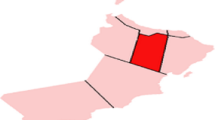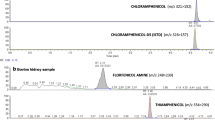Abstract
In Benin, veterinary antibiotics are widely used for cattle breeding. This livestock contributes to 57% of the locally produced meat. The aim of this study was to assess the impact of the large use of antibiotics by determining the contamination level with antibiotic residues in bovine meat, in North Benin. Kidney and muscle samples taken from 50 bovine carcasses in the 2 main slaughterhouses of Parakou were analyzed for the presence of antibiotic residues by a screening method modified from the “New Two Plates Test” (NTPT), to identify tetracyclines, sulfonamides, and beta-lactam groups of antibiotics. Thirteen kidney and muscle samples were subjected to liquid chromatography coupled to tandem mass spectrometry analysis for the confirmation of tetracycline and sulfonamide residues. After modified NTPT screening, tetracycline residues were identified in 54% of cattle carcasses while beta-lactam and sulfonamide residues were present, respectively, in 2 and 6% of sampled animals. The LC-MS/MS analysis confirmed the presence in the kidney tissue of oxytetracycline, epi-oxytetracycline, tetracycline, and epi-tetracycline at maximum levels, respectively, of 1380, 350, 190, and 230 μg kg−1. Sulfamethazine residues were confirmed in one of cattle carcass at very high levels of 3900 μg kg−1 in kidney and 2220 μg kg−1 in muscle. Antibiotic residue levels were found above the maximum residue limit applied in the European legislation in 38% of the carcasses subjected to the LC-MS/MS analysis. These high levels of contamination with antibiotic residues are a potential threat for the health of consumers, and are of concern regarding the selection of antibiotic-resistant bacteria in animals and humans.



Similar content being viewed by others
References
Abouzied M, Driksna D, Walsh C, Sarzynski M, Walsh A, Ankrapp D, Klein F, Rice J, Mozola M (2012) Validation study of the BetaStar (R) plus lateral flow assay for detection of beta-lactam antibiotics in milk. J AOAC Int 95:1211–1221
Ahmed S, Ning J, Cheng G, Ahmad I, Li J, Mingyue L, Qu W, Iqbal M, Shabbir MAB, Yuan Z (2017) Receptor-based screening assays for the detection of antibiotics residues—a review. Talanta 166:176–186
AM (1995) Arrêté Ministériel du 19 juin 1995 modifiant l’arrêté ministériel du 18 décembre 1973 déterminant les techniques de laboratoire pour la recherche des résidus de substances à effet bactériostatique. Moniteur Belge du 2807.1995, 20368–20370
Bedada AH, Zewde BM (2012) Tetracycline residue levels in slaughtered beef cattle from three slaughterhouses in central Ethiopia. J Glob Vet 8(6):546–554
Boison J.O. (1995) Chemical analysis of β-lactam antibiotics. In: chemical analysis for antibiotics used in agriculture, H. Oka, H. Nakazawa, K-I. Harada, J.D. Macneil, editors, AOAC international
Cháfer-Pericás C, Maquieira Á, Puchades R (2010) Fast screening methods to detect antibiotic residues in food samples. TrAC 29(9):1038–1049
Chantziaras I, Boyen F, Callens B, Dewulf J (2014) Correlation between veterinary antimicrobial use and antimicrobial resistance in food-producing animals: a report on seven countries. J Antimicrob Chemother 69(3):827–834
Chen T, Cheng G, Ahmed S, Wang Y, Wang X, Hao H, Yuan Z (2017) New methodologies in screening of antibiotic residues in animal-derived foods: biosensors. Talanta 175:435–442
Chopra I, Roberts M (2001) Tetracycline antibiotics: mode of action, applications, molecular biology, and epidemiology of bacterial resistance. Microbiol Mol Biol R 65(2):232–260
Darwish WS, Eldaly EA, El-Abbasy MT, Ikenaka Y, Nakayama S, Ishizuka M (2013) Antibiotic residues in food: the African scenario. Jpn J Vet Res 61(Suppl):S13–S22
De Wasch K, Okerman L, Croubels S, De Brabander H, Hoof JV, De Backer P (1998) Detection of residues of tetracycline antibiotics in pork and chicken meat: correlation between results of screening and confirmatory tests. Analyst 123:2737–2741
EFSA (European Food Safety Authority) (2015) Report for 2014 on the results from the monitoring of veterinary medicinal product residues and other substances in live animals and animal products. http,//www.efsa.europa.eu/en/supporting/pub/923e. Accessed 09 Nov 2017
EU (2010) Commission Regulation (EU) No 37 / 2010 of 22 December 2009 on pharmacologically active substances and their classification regarding maximum residue limits in foodstuffs of animal origin. Off J, L15, 1–72
Founou LL, Founou RC, Essack SY (2016) Antibiotic resistance in the food chain: a developing country-perspective. Front Microb 7:1881
Gaudin V (2017) Advances in biosensor development for the screening of antibiotic residues in food products of animal origin—a comprehensive review. Biosens Bioelectron 90:363–377
Granados-Chinchilla F, Rodríguez C (2017) Tetracyclines in food and Feedingstuffs: from regulation to analytical methods, bacterial resistance, and environmental and health implications. J Analytical Methods in Chemistry 2017, article ID 1315497, 24 pages
Griffin MO, Ceballos G, Villarreal FJ (2011) Tetracycline compounds with non-antimicrobial organ protective properties: possible mechanisms of action. Pharmacol Res 63:102–107
Kimera ZI, Mdegela RH, Mhaiki CJN, Karimuribo ED, Mabiki F, Nonga HE, Mwesongo J (2015) Determination of oxytetracycline residues in cattle meat marketed in the Kilosa district, Tanzania. Onderstepoort J Vet Res 82(1):911
Landers TF, Cohen B, Wittum TE, Larson EL (2012) A review of antibiotic use in food animals: perspective, policy, and potential. Public Health Rep 127(1):4–22
Majdinasab M, Yaqub M, Rahim A, Catanante G, Hayat A, Marty JL (2017) An overview on recent progress in electrochemical biosensors for antimicrobial drug residues in animal-derived food. Sensors 17(9):1947
Marshall BM, Levy SB (2011) Food animals and antimicrobials: impacts on human health. Clin Microbiol Rev 24:718–733
Mensah SEP, Ahissou HY, Koudande OD, Salifou S, Mensah GA, Abiola FA (2011) Detection of antibiotics residues in meat of reformed and marketed laying hens in southern Benin. Int J Biol Chem Sci 5(6):2195–2204
Mensah SE, Koudandé OD, Sanders P, Laurentie M, Mensah GA, Abiola FA (2014) Antimicrobial residues in foods of animal origin in Africa: public health risks. Rev Sci Tech 33(3):987–996 975-86
Naik L, Sharma R, Mann B, Lata K, Rajput YS, Nath BS (2017) Rapid screening test for detection of oxytetracycline residues in milk using lateral flow assay. Food Chem 219:85–92
Nisha AR (2008) Antibiotics residues—a global health hazard. Vet World 1(12): 375–377
Oh YH, Han HK (2006) Pharmacokinetic interaction of tetracycline with non-steroidal anti-inflammatory drugs via organic anion transporters in rats. Pharmacol Res 53:75–79
Olufemi OI, Agboola EA (2009) Oxytetracycline residues in edible tissues of cattle slaughtered in Akure, Nigeria. Internet J Food Saf 11:62–66
Pham Kim D, Degand G, Danyi S, Pierret G, Delahaut P, Vu Dinh T, Maghuin-Rogister G, Scippo ML (2010) Validation of a two-plate microbiological method for screening antibiotic residues in shrimp tissue. Anal Chim Acta 672:30–39
Pham Kim D, Degand G, Douny C, Vu Dinh T, Maghuin-Rogister G, Scippo ML (2011) Optimisation of a new two-plate screening method for the detection of antibiotic residues in meat. Int J Food Sci Tech 46:2070–2076
Pham Kim D, Degand G, Douny C, Pierret G, Delahaut P, Vu Dinh T, Granier B, Scippo ML (2013) Preliminary evaluation of antimicrobial residue levels in marketed pork and chicken meat in the Red River Delta region of Vietnam. Food Public Health 3(6):267–276
Pikkemaat MG, Rapallini MLBA, Oostra-Van Dijk S, Elferink JWA (2009) Comparison of three microbial screening methods for antibiotics using routine monitoring samples. Anal Chim Acta 637:298–304
Sajid M, Kawde AN, Daud M (2015) Designs, formats and applications of lateral flow assay: a literature review. J Saudi Chem Soc 19(6):689–705
Salama NA, Abou-Raya SH, Shalaby AR, Emam WH, Mehaya FM (2011) Incidence of tetracycline residues in chicken meat and liver retailed to consumers. Food Addit Contam B 4:88–93
Sarmah AK, Meyer MT, Boxall AB (2006) A global perspective on the use, sales, exposure pathways, occurrence, fate and effects of veterinary antibiotics (VAs) in the environment. Chemosphere 65(5):725–759
Stead S, Sharman M, Tarbin JA, Gibson E, Richmond S, Stark J, Geijp E (2004) Meeting maximum residue limits: an improved screening technical for the rapid detection of antimicrobial residues in animal food products. Food Addit Contam 21(3):216–221
Van Boeckel TP, Brower C, Gilbert M, Grenfella BT, Levin SA, Robinson TP, Teillant A, Laxminarayan R (2015) Global trends in antimicrobial use in food animals. PNAS 112(18):5649–5654
Virolainen N, Karp M (2014) Biosensors, antibiotics and food. Adv Biochem Eng Biotechnol 145:153–185
Vishnuraj MR, Kandeepan G, Rao KH, Chand S, Kumbhar V (2016) Occurrence, public health hazards and detection methods of antibiotic residues in foods of animal origin: a comprehensive review. Cogent Food Agric 2(1):1235458
Acknowledgements
The authors thank the responsible Rural Development of Parakou, veterinarians, and cattle butchers of this town. They are grateful to DREAM ACP scholarship project which funded the stay of the first author in Belgium.
Author information
Authors and Affiliations
Corresponding author
Ethics declarations
Conflict of Interest
Robert Dognon declares that he has no conflict of interest. Guy Degand declares that he has no conflict of interest. Caroline Douny declares that she has no conflict of interest. Philippe Delahaut declares that he has no conflict of interest. Ahmed Igout declares that he has no conflict of interest. Mahamadou Dahouda declares that he has no conflict of interest. Issaka A.K. Youssao declares that he has no conflict of interest. Marie-Louise Scippo declares that she has no conflict of interest.
Ethical Approval
All applicable international, national, and/or institutional guidelines for the care and use of animals were followed.
Informed Consent
Not applicable.
Rights and permissions
About this article
Cite this article
Dognon, S.R., Degand, G., Douny, C. et al. The Modified New Two Plates Test for Detecting Tetracycline, Beta-Lactam, and Sulfonamide Antibiotic Residues in Kidney and Muscle of Cattle Slaughtered in North-East Benin. Food Anal. Methods 11, 3406–3416 (2018). https://doi.org/10.1007/s12161-018-1322-y
Received:
Accepted:
Published:
Issue Date:
DOI: https://doi.org/10.1007/s12161-018-1322-y




